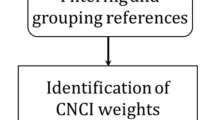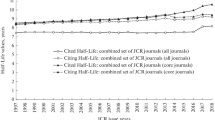Abstract
Since the publication of the first academic journal in 1665, the number of academic journal titles has grown steadily. In 2001, Mabe and Amin studied the pattern of growth in the number of academic journals worldwide, identifying three key development periods between 1900 and 1996. These three episodes are from 1900 to 1944, from 1944 to 1978, and from 1978 to 1996. The compound annual growth rates for each episode are 3.30, 4.68 and 3.31 % respectively. In this research, we seek to validate these findings, and extend on previous work to analyze journal growth patterns from 1986 to 2013. Our results show academic journals grew at an average rate of 4.7 % from 1986 to 2013, which is very similar to the growth rate during the Big Science period observed in the previous study. Our results also show that academic journals had an estimated 92 % Active rate, and 8 % Inactive rate annually. Out of all Active journals, approximately 43 % have high impact and reach JCR or SJR databases, and 26 % have relatively higher impact and are thus collected in the JCR database. The comparison results of Active/Inactive SJR and JCR journals suggest that lower impact journals have a higher chance to become Inactive than higher impact journals. With the wide use of the Internet in academic science, our results expectedly show that the number of Print-Only journals is gradually decreasing while the number of Online-Only journals is increasing. The growth of Online-Only journals exceeds the growth of Print-Only journals in 2007, and the number of Online-Only journals exceeded the number of Print and Only journals in 2012. More than 30 % Newly Created journals provide Open Access. It is suggested that we are experiencing the second journal boom in history and Internet technology has changed the academic publication system.















Similar content being viewed by others
References
Alonso, S., Cabrerizo, F. J., Herrera-Viedma, E., & Herrera, F. (2009). h-Index: A review focused in its variants, computation and standardization for different scientific fields. Journal of Informetrics, 3(4), 273–289.
Björk, B.-C. (2006). A model of scientific communication as a global distributed information system. Information research, 12(2), 17.
Björk, B.-C., & Hedlund, T. (2004). A formalised model of the scientific publication process. Online Information Review, 28(1), 8–21.
Björk, B.-C., Roos, A., & Lauri, M. (2008). Global annual volume of peer reviewed scholarly articles and the share available via different Open Access options. Paper presented at the ELPUB2008.
Blake, G., & Bly, R. W. (1993). The elements of technical writing. London: Longman.
Boyce, P. B., & Dalterio, H. (2008). Electronic publishing of scientific journals. Physics Today, 49(1), 42–47.
Buela-Casal, G., Perakakis, P., Taylor, M., & Checa, P. (2006). Measuring internationality: Reflections and perspectives on academic journals. Scientometrics, 67(1), 45–65.
Byrd, G. D. (1990). An economic” Commons” tragedy for research libraries: Scholarly journal publishing and pricing trends. College and Research Libraries, 51(3), 184–195.
Cronin, B., Shaw, D., & La Barre, K. (2003). A cast of thousands: Coauthorship and subauthorship collaboration in the twentieth century as manifested in the scholarly journal literature of psychology and philosophy. Journal of the American Society for Information Science and Technology, 54(9), 855–871.
Day, R., & Gastel, B. (2012). How to write and publish a scientific paper. Cambridge: Cambridge University Press.
De Solla Price, D. J. (1963). Little science, Big Science. Von der Studierstube bis zur.
Elsevier. Scopus. From Elsevier: http://www.scopus.com/.
Felton, A., Fischer, J., Lindenmayer, D. B., Montague-Drake, R., Lowe, A. R., Saunders, D., et al. (2009). Climate change, conservation and management: an assessment of the peer-reviewed scientific journal literature. Biodiversity and Conservation, 18(8), 2243–2253.
Guerrero, R., & Piqueras, M. (2010). Open access. A turning point in scientific publication. International Microbiology, 7(3), 157–161.
Hajjem, C., Harnad, S., & Gingras, Y. (2006). Ten-year cross-disciplinary comparison of the growth of open access and how it increases research citation impact. arXiv preprint cs/0606079.
Hames, I. (2008). Peer review and manuscript management in scientific journals: Guidelines for good practice. New York City: Wiley.
Harnad, S., & Brody, T. (2004). Comparing the impact of open access (OA) vs. non-OA articles in the same journals. D-lib Magazine, 10(6). http://www.dlib.org/dlib/june04/harnad/06harnad.html.
Hazelkorn, E. (2009). Rankings and the battle for world-class excellence: Institutional strategies and policy choices.
Hazelkorn, E. (2013). How Rankings are Reshaping Higher Education? Paper presented at the IAU 13th General Conference. The Netherlands: Utrecht.
Hew, M. (2001). Scholarly journal publishing in Malaysia. Journal of Scholarly Publishing, 32(3), 164–168.
Hirsch, J. E. (2005). An index to quantify an individual’s scientific research output. Proceedings of the National Academy of Sciences of the United States of America, 102(46), 16569.
Jacot, A. P. (1937). Principles of scientific publication. Journal of the New York Entomological Society, 45(1), 127–129.
Jinha, A. E. (2010). Article 50 million: an estimate of the number of scholarly articles in existence. Learned Publishing, 23(3), 258–263.
Kalaitzidakis, P., Mamuneas, T. P., & Stengos, T. (2003). Rankings of academic journals and institutions in economics. Journal of the European Economic Association, 1(6), 1346–1366.
Krimsky, S., Rothenberg, L., Stott, P., & Kyle, G. (1996). Financial interests of authors in scientific journals: a pilot study of 14 publications. Science and Engineering Ethics, 2(4), 395–410.
Krimsky, S., Rothenberg, L., Stott, P., & Kyle, G. (1998). Scientific journals and their authors’ financial interests: A pilot study. Psychotherapy and Psychosomatics, 67(4–5), 194–201.
Mabe, M. (2003). The growth and number of journals. Serials: The Journal for the Serials Community, 16(2), 191–197.
Mabe, M., & Amin, M. (2001). Growth dynamics of scholarly and scientific journals. Scientometrics, 51(1), 147–162.
Meho, L. I., & Yang, K. (2007). Impact of data sources on citation counts and rankings of LIS faculty: Web of Science versus Scopus and Google Scholar. Journal of the American Society for Information Science and Technology, 58(13), 2105–2125.
Microsoft. Microsoft Excel (Version 2010).
Mišak, A., Marušić, M., & Marušić, A. (2005). Manuscript editing as a way of teaching academic writing: Experience from a small scientific journal. Journal of Second Language Writing, 14(2), 122–131.
Moed, H. F. (2010). Measuring contextual citation impact of scientific journals. Journal of Informetrics, 4(3), 265–277.
Morris, S. (2005). The true costs of scholarly journal publishing. Learned Publishing, 18(2), 115–126.
Morris, S. (2007). Mapping the journal publishing landscape: how much do we know? Learned Publishing, 20(4), 299–310.
Oppenheim, C., Greenhalgh, C., & Rowland, F. (2000). The future of scholarly journal publishing. Journal of Documentation, 56(4), 361–398.
Peek, R. P., & Pomerantz, J. P. (1998). Electronic scholarly journal publishing. Annual Review of Information Science and Technology, 33, 321–356.
Pringle, J. (2004). Do open access journals have impact. Nature Web Focus, 18.
Relman, A. S. (1990). Peer review in scientific journals–what good is it? Western Journal of Medicine, 153(5), 520.
Ren, S., & Rousseau, R. (2002). International visibility of Chinese scientific journals. Scientometrics, 53(3), 389–405.
Rosenstreich, D., & Wooliscroft, B. (2006). How international are the top academic journals? The case of marketing. European Business Review, 18(6), 422–436.
Rowland, F. (2005). Scholarly journal publishing in New Zealand. Learned Publishing, 18(4), 300–310.
Scopus. SCImago Journal & Country Rank—Journal Rankings. From http://www.scimagojr.com/journalrank.php.
Statzner, B., & Resh, V. H. (2010). Negative changes in the scientific publication process in ecology: potential causes and consequences. Freshwater Biology, 55(12), 2639–2653.
Tenopir, C., & King, D. W. (1997). Trends in scientific scholarly journal publishing in the United States. Journal of Scholarly Publishing, 28(3), 135–170.
Tenopir, C., & King, D. W. (2009). The growth of journals publishing. Oxford: Chandos Oxford.
Thomson Reuters. Web of Science. From Thomson Reuters: http://apps.webofknowledge.com/.
Zitt, M., & Bassecoulard, E. (1998). Internationalization of scientific journals: a measurement based on publication and citation scope. Scientometrics, 41(1), 255–271.
Author information
Authors and Affiliations
Corresponding author
Rights and permissions
About this article
Cite this article
Gu, X., Blackmore, K. Recent trends in academic journal growth. Scientometrics 108, 693–716 (2016). https://doi.org/10.1007/s11192-016-1985-3
Received:
Published:
Issue Date:
DOI: https://doi.org/10.1007/s11192-016-1985-3




